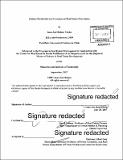| dc.contributor.advisor | David Geltner. | en_US |
| dc.contributor.author | Bulnes Valdes, Juan José | en_US |
| dc.contributor.other | Massachusetts Institute of Technology. Center for Real Estate. Program in Real Estate Development. | en_US |
| dc.coverage.spatial | s-cl--- | en_US |
| dc.date.accessioned | 2018-02-08T16:26:01Z | |
| dc.date.available | 2018-02-08T16:26:01Z | |
| dc.date.copyright | 2017 | en_US |
| dc.date.issued | 2017 | en_US |
| dc.identifier.uri | http://hdl.handle.net/1721.1/113486 | |
| dc.description | Thesis: S.M. in Real Estate Development, Massachusetts Institute of Technology, Program in Real Estate Development in conjunction with the Center for Real Estate, 2017. | en_US |
| dc.description | Cataloged from PDF version of thesis. | en_US |
| dc.description | Includes bibliographical references (page 53). | en_US |
| dc.description.abstract | In the history of the Chilean real estate market, little has been done to study the price dynamic of real estate. Currently, the Chilean industry has two types of residential indices that do not effectively present the available information. One of the existing indices uses the correct methodology (Hedonic Method), but it does not represent the whole metropolitan residential market. The second index has enough data, but the methodology (stratification or mixed adjustment method) is not the most appropriate because of its simplicity, given the great quantity of information available on the market. We briefly review different index methodologies, and base an extensive database on reliable information from the greater Santiago market. We created two types of Hedonic price indices (Pooled and Chained) for residential and commercial real estate, respectively. These hedonic methodologies are based on an econometric model to account for the problem of the heterogeneity of real estate; each property is unique within its characteristics, and should not be read independently. Thus, the objective of an index is to estimate the marginal contribution of those characteristics and generate a quality-adjusted price index. Between the two different results, we analyze the advantages and disadvantages of each methodology, and why should choose one over the other in each situation. For the most of the results we obtained, they are consistent with the existing indices having nominal return of 98% and 117% for the residential market and 58% for the commercial. Our indices show some subtle differences, and they are based on a more rigorous and sophisticated methodology that is consistent with the recommendations of the Eurostat International CPPI Handbook. Finally, this document should be the first step to internationalize and professionalize the processes of measurement and should be helpful to make better public and private decisions within the Chilean real estate market. | en_US |
| dc.description.statementofresponsibility | by Juan José Bulnes Valdes. | en_US |
| dc.format.extent | 59 pages | en_US |
| dc.language.iso | eng | en_US |
| dc.publisher | Massachusetts Institute of Technology | en_US |
| dc.rights | MIT theses are protected by copyright. They may be viewed, downloaded, or printed from this source but further reproduction or distribution in any format is prohibited without written permission. | en_US |
| dc.rights.uri | http://dspace.mit.edu/handle/1721.1/7582 | en_US |
| dc.subject | Center for Real Estate. Program in Real Estate Development. | en_US |
| dc.title | Chilean residential and commercial real estate price index | en_US |
| dc.type | Thesis | en_US |
| dc.description.degree | S.M. in Real Estate Development | en_US |
| dc.contributor.department | Massachusetts Institute of Technology. Center for Real Estate. Program in Real Estate Development. | en_US |
| dc.contributor.department | Massachusetts Institute of Technology. Center for Real Estate | |
| dc.identifier.oclc | 1019908303 | en_US |
